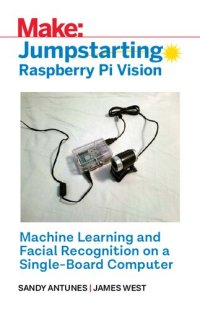
Ebook: Jumpstarting Raspberry Pi Vision
Author: Sandy Antunes James West
- Year: 2018
- Publisher: Maker Media
- Language: English
- pdf
If a camera takes a picture and no one notices, did it really happen? In this book, we’re going to show you how to make a working Raspberry Pi–based camera system so that you can capture time-lapse images and view via WiFi, trigger the camera if motion is detected, and even carry out basic facial recognition as an introduction to machine learning methods.
Take a Raspberry Pi and add a camera module, and you have a programmable camera. Add some software, and you can start to do interesting surveillance and automatic object recognition work with it. Activate the Pi as a WiFi node and you can do all these wonderful things from a distance.
A good surveillance system does more than take pictures. It should also turn those pictures into actionable information that increases your knowledge. That’s now easily done in software, and we’re going to show you how.
This book pulls together a set of little tricks—setting up Pi cameras, making a Pi broadcast as a WiFi device, adding time lapse and motion detection and face recognition, and sticking a battery pack on it so it can function anywhere—to create portable spy cameras. We’ve used these rigs in everything from “Find the Pi” party contests, to implementing privacy-respecting security in our lab, to showing off modern tech like facial recognition. Other uses could include monitoring deer and wildlife, checking your house mailbox for mail arrival, and capturing time-lapse sequences of natural events or traffic patterns.
Our first project will be to create a portable “SpyPi” camera rig that broadcasts images via WiFi without needing a network—you just have to log into it to see what the camera sees . It’s great for a “find the camera” hunting challenge or stand-alone security.
The second project will involve setting up a time-lapse camera that can do simple motion detection—perfect for monitoring a location. The system will include automatic deletion of old images after a week.
The third project will be to add facial detection and facial recognition to your SpyPi. In the process, you’ll learn about the tools and software installed by the end of these projects so that you can go beyond this book and explore additional machine learning methods.
So grab a Pi, an SD card, a USB camera, and a USB battery pack, and let’s go!